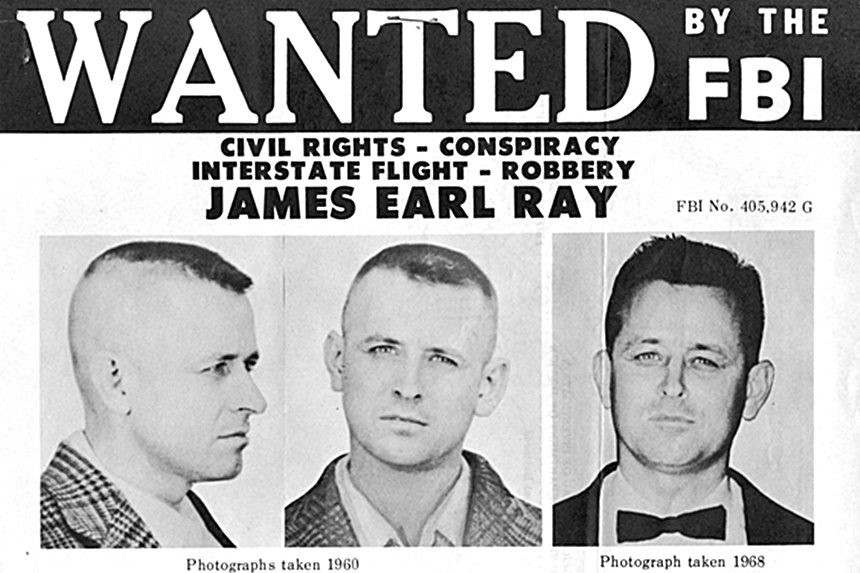Top 13 Most Wanted Lost Objects Around The World
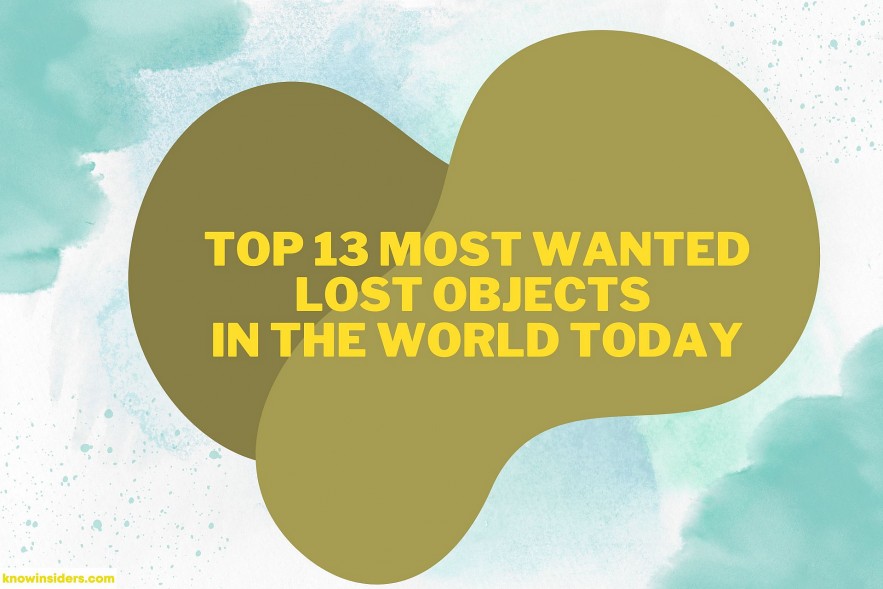 |
| The Most Wanted Lost Objects In The World Today. Photo KnowInsiders |
| Table of Contents |
The world is full of incredible objects, many of which date back hundreds, thousands, or even millions of years. Some of these treasures have gone, so the next exciting chapter in these fascinating stories has not yet been written.
These ten and more of the most sought-after missing objects in history include a holy cup believed to have once held the blood of Jesus Christ and the most elaborate Easter eggs ever created!
Top 13 most wanted lost objects in the world
1. Barber Dimes
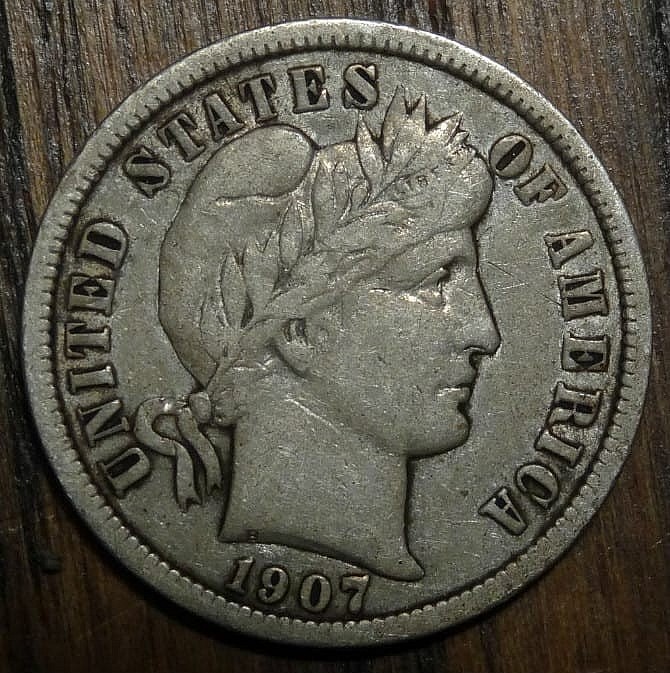 |
| Photo Luxatic |
A stash of 10-cent coins wouldn't seem to be very valuable, normally. However, what if there were actually a truckload of those coins and their value exceeded their face value?
Millions of 1907 Barber dimes were struck, but only a small number of them are in good shape. A wagon train is said to have carried six barrels full of these coins when it departed Denver for Phoenix in 1907, but the shipment never made it. The mystery itself is intriguing enough; some believe the wagon train was ambushed by outlaws, while others surmise it fell to the bottom of Colorado's Black Canyon while attempting to negotiate the treacherous mountain paths. However, the shipment's value adds even more allure. A few thousand of these coins, if they are still in good condition, could be worth millions of dollars today, especially considering the mystery surrounding their mysterious disappearance from all those years ago.
2. Romanov Easter Eggs
 |
| Photo Wikipedia |
Russian jeweler Peter Carl Faberge was descended from France. He is renowned for the exquisite beauty and high caliber of his creations, particularly the well-known Faberge Eggs.
Tsar Alexander III started the royal tradition of the Faberge Eggs when he ordered a decorative Easter egg from Faberge's studio in 1885 as a present for his wife, Empress Maria Feodorovna.
Upon receiving the gift, Maria Feodorovna observed that it was a typical egg crafted from white gold. However, the egg held a few surprises that the emperor had planned. She discovered a golden yolk when she opened it. Like the Russian matryoshka, there were more surprises inside the egg. When the yolk was cracked open, a golden hen with ruby eyes would show itself.
A small ruby for the Empress to wear on a chain around her neck and a miniature replica of the imperial crown made of gold and diamonds were both found inside the golden hen. The original egg is still known as "Hen" in history.
From this point on, until Alexander III's passing, the crown would order Faberge to create one egg annually for him. Nicholas II, his successor, carried on this custom by placing 44 additional orders for eggs.
Since several of the eggs were made for other wealthy Russian families, the precise number of eggs is still unknown. It is thought that there were roughly 70 in total, but the reason why 8 of the royal eggs are missing remains a mystery.
Millions of dollars are spent on each of the remaining Faberge eggs, indicating that the ones that are missing would be even more valuable.
What were the eggs made of?The Romanov Tercentenary Egg is crafted from ivory and includes elements such as vitreous enamel, turquoise, purpurine, rock crystal, gold, silver, rose-cut and portrait diamonds, and watercolor painting. The egg commemorates the three hundred years of Romanov rule from 1613 to 1913, or the tercentenary of the Romanov dynasty. |
| With fifteen Fabergé eggs (two Kelch, four other Fabergé eggs, and nine Imperial), Viktor Vekselberg is the world's largest owner. Vekselberg disclosed that he had paid slightly more than $100 million for the nine Fabergé Imperial eggs from the Forbes collection in a 2013 BBC Four documentary.He asserts that he never put them on display in his house and that he only purchased them because he thought they were the greatest works of jewelry art in the entire world and because they are significant to Russian history and culture. Vekselberg disclosed plans to create a museum to house his collection of eggs in the same BBC documentary. |
3. The Golden Owl
At three in the morning on April 22, 1993, a man buries an object somewhere in France. At least at the time, it was thought that the man, who goes by Max Valentin, had just hidden a bronze statue of an owl, which is an artifact. The original, a diamond-encrusted gold and silver owl valued at one million francs (150,000 euros), was reportedly hidden away in a safe. It was a true treasure.
A book with roughly sixty pages that was released a few weeks after the nocturnal burial contains eleven enigmas that treasure seekers must solve in order to retrieve it. The enigmas are written like parables. Signed by two accomplices who banded together, Max Valentin and Michael Becker, on the trail of the golden owl.
The first goes under a pseudonym; nobody initially knows who he is. The other is a little-known artist. Becker created the golden owl sculpture and the book's illustrations. The story goes that thousands will soon be searching for the priceless bird.
READ MORE: Top 100 Most Valuable Brands in the World
4. The Holy Grail
The holy grail of lost treasures is known as the Holy Grail. Since the 12th century at the latest, religious fanatics and fortune tellers have developed an obsession with the cup that Jesus drank from during the Last Supper. It is said that one can obtain healing, eternal youth, or even eternal happiness by drinking from the grail.
Perceval and King Arthur asked for it. The Nazis went looking for it. Monty Python, Nicolas Cage, and Indiana Jones all did as well. Nazi officials believed it to be in Catalonia. Some claim it is in Scotland. or Britain. or Minnesota, perhaps.
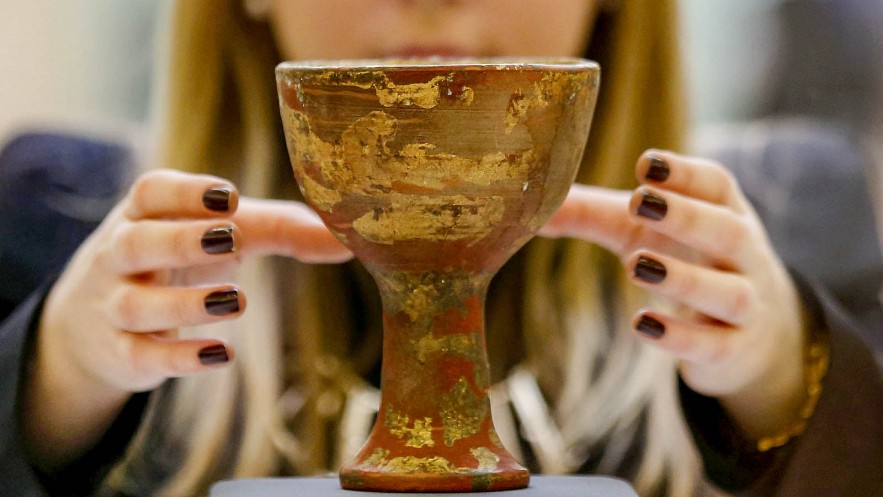 |
| Photo CNN |
The grail was allegedly discovered in 2014 by archaeologists Margarita Torres and José Ortega in the Basilica of San Isidoro in León, Spain's basement museum. It is unclear if Torres and Ortega's grail is the one genuine grail, even though carbon dating suggests that it is an extremely old goblet. One of the primary issues with grail-location is contained there: Just in Europe, there are 200 supposed holy grails. Who knows which one of them is the real deal?
The description of the grail in the Bible is utterly vague. The only place it is mentioned is in Matthew 26:27–28. It says, "After giving thanks, he took a cup and gave it to them [the disciples], saying, 'Drink from it, all of you.'" This is my covenantal blood, poured out for many to receive sin forgiveness.
5. Atahualpa’s Gold
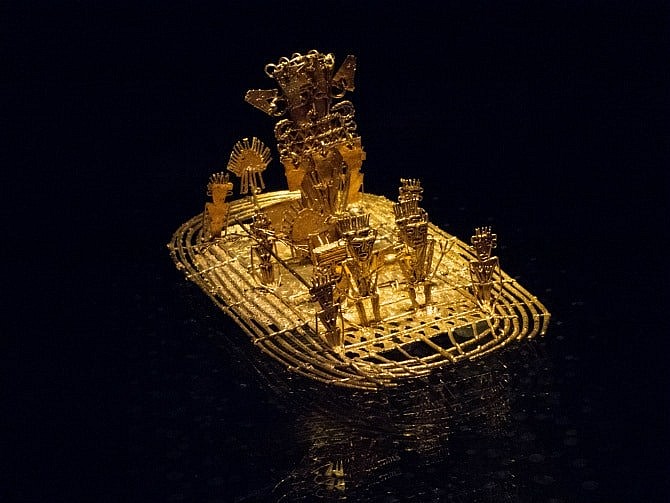 |
| Photo Luxatic |
The wealth of the native kingdoms in the New World astounded the Conquistadors when they landed there approximately 500 years ago. Little but tenacious (and technologically more advanced) Spanish groups began pillaging and occupying the region before these natives knew what hit them (the word conquistador literally means conqueror).
Such a group was led by Francisco Pizarro to the Inca Empire ruled by Atahualpa in modern-day Peru. Francisco Pizzaro and his men were vastly outnumbered, but they prevailed because they had access to modern weapons and armor, like horses. After being taken prisoner in an ambush, Atahualpa made an offer to be freed by paying (literally) a room full of gold and twice as much in silver, but he was killed before the deal could be finalized. People have been looking for the enormous treasure that the Incas gathered to pay their king a ransom for centuries, but nothing truly valuable has ever been discovered, with the exception of a few artifacts.
READ MORE: Top 9 Countries That Are The Largest Gold-Producers In The World Today
6. Ark of the Covenant
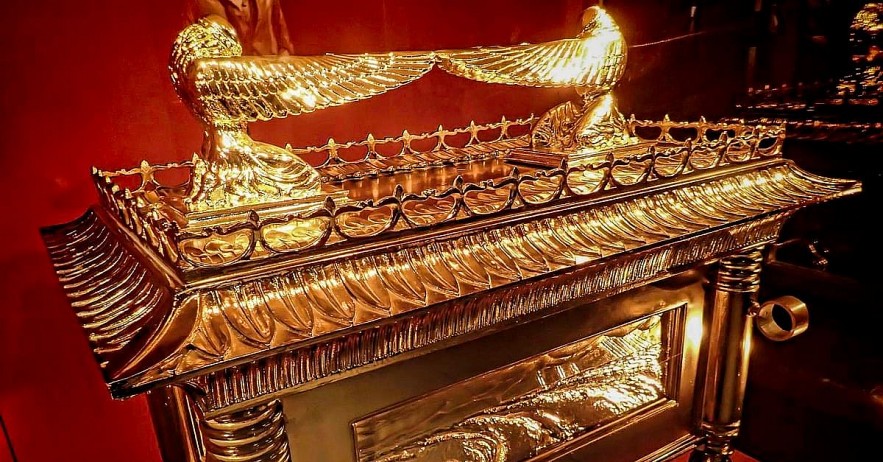 |
| Photo world history |
Without a doubt, one of the most enigmatic items mentioned in the Bible is still the Ark of the Covenant. Everyone is familiar with Steven Spielberg's timeless masterpiece "Raiders of the Lost Ark," in which the valiant Indiana Jones underwent incredible adventures in order to find the priceless artifact. However, precisely what was the ark?
The Bible describes it as a chest made of acacia wood with a gold casing that represented God's presence among the people. A golden pot containing the "heavenly manna," Aaron's rod, and two plates bearing God's commandments—which the prophet Moses had received on Mount Sinai—were all kept within.
The Jews transported the ark to the Promised Land. Yahweh's people had unbreakable power due to his supernatural abilities. The ark's power caused the Jordan River to dry up, allowing the Israelites to cross, and it also sent sicknesses to the Philistines, daring them to oppose God's chosen people.
In the seventh century BC, during King Josiah's reign, the ark remained intact. It was not listed among the artifacts and treasures taken from Solomon's temple, leading experts to believe that it was lost during the Babylonian King Nebuchadnezzar's conquest of Jerusalem in 587 BC or earlier. The Israelites never built another ark in obedience to God's command, and its secret was lost forever.
7. Polish Crown Jewels
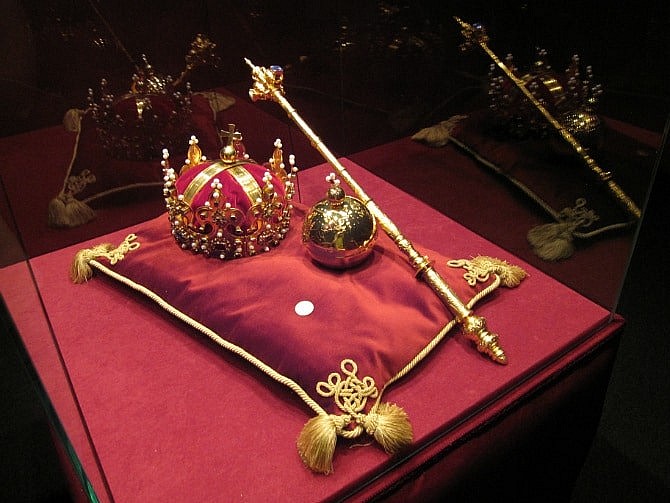 |
| Photo Luxatic |
The Poles weren't exactly having the best of times at the end of the 18th century. The once-mighty kingdom was split between the Austrian Empire, the Kingdom of Prussia, and Tsarist Russia—three of Europe's superpowers—until nothing remained.
The Polish Crown Jewels predate the nation by nearly two millennia. An inventory carried out in 1633 revealed that the collection consisted of several crowns, scepters, chains, and swords made for different occasions and famous historical figures, all of which were kept in five chests. The Prussians took possession of the treasure in 1794 and moved it to Berlin. The Polish Crown Jewels met a less than spectacular end in 1809 when they were melted down for their gold. The Szczerbiec, a ceremonial sword that is on display in Krakow, is the only one that survived.
8. Crown Jewels of Ireland
The "Crown Jewels of Ireland"—regalia belonging to the Grand Master of the Order of St. Patrick—were found to be missing on July 6, 1907, with the keys obdurately left hanging in the safe's lock. The expensive pieces, which came with a badge and diamond star, were given to the order of knights in 1830. Five knight members' collars had also been spirited off, adding insult to injury.
Maybe there was too much lax security. Dublin Castle had a safe room constructed in 1903, but the safe containing the jewels was too large to fit through the door, so it was kept in a strongroom in the library.
Despite the prompt investigation, the case remains unsolved even after a century has passed. There is a rumor that Edward VII ordered the investigation to be stopped because it revealed details of a sexual scandal that occurred at Dublin Castle. Francis Shackleton, the brother of renowned explorer Ernest Shackleton and second-in-command at the castle, is one of the main suspects; some speculate that he may have been attempting to raise money for his brother's polar expedition.
9. The Amber Room
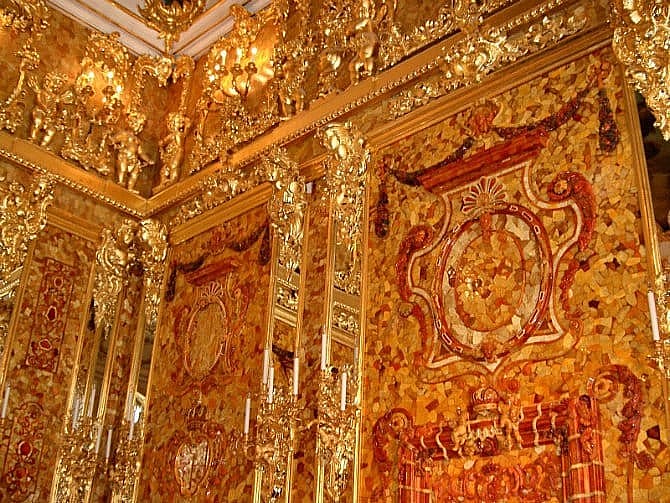 |
| Photo Luxatic |
The pride and joy of the Romanov House, the Amber Room was a symbol of both German and Russian masterpieces. It vanished inexplicably during World War II and has remained unidentified ever since. The location of the original Amber Room continues to be a topic of discussion among enthusiasts, even though Russian masters and scientists are reconstructing this incredible location in the twenty-first century.
The first Russian emperor, Peter the Great, who ruled from 1682 to 1721, is renowned for his fascination with oddities. His collection of odd and distinctive artifacts, known as the Kunstkamera, is still on exhibit in St. Petersburg. It is a room filled with extraordinary items, ranging from minerals to malformed human embryos.
Every European king, even during Peter's reign, was aware that giving the strong Russian tsar a remarkable gift was the best way to win him over.
Friedrich Wilhelm I, the Prussian, did this in an attempt to gain Peter's favor. He gifted the Russian emperor a room in 1716 that was created by the best Baroque Prussian sculptors and architects and embellished with gold and amber accents. This was the well-known Amber Room, which due to its extraordinary beauty was eventually dubbed the Eighth Wonder of the World.
Germany formally declared under Adolf Hitler's rule that the German people had stolen numerous pieces of art dating back centuries, including the room.
Alfred Rode, a German art critic who is said to have taken care of the stolen Amber Room, claims that it escaped even the 1944 heavy bombings of Königsberg, where it was purportedly kept. But once they had taken the city, the Soviet forces discovered nothing of it.
10. The Honjō Masamune
At the end of World War II, private weapons, including antiques, were forced from Japan's citizens. Among them was the Honjō Masamune of the Kamakura period, one of the most famous swords in history. The sword, which was praised for its strength and artistry, was made by Masamune, who is thought to be the greatest swordsmith in Japan and lived from approximately 1260 to 1340.
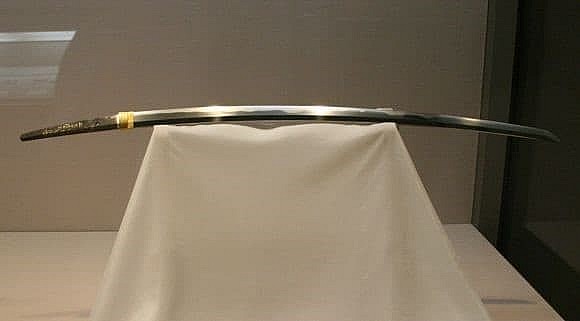 |
| Photo ubisoft |
Tokugawa Iemasa was its last owner. He obeyed orders from the Allies and brought the Honjō Masamune to a Tokyo police station along with other heirloom swords. After being given to a member of the Army Forces, Western Pacific's Foreign Liquidations Commission, they vanished. While some of the era's surrendered swords were melted down or thrown into the sea, others were carried back to the United States by American soldiers. The Honjō Masamune's current whereabouts are unknown.
11. The Florentine Diamond
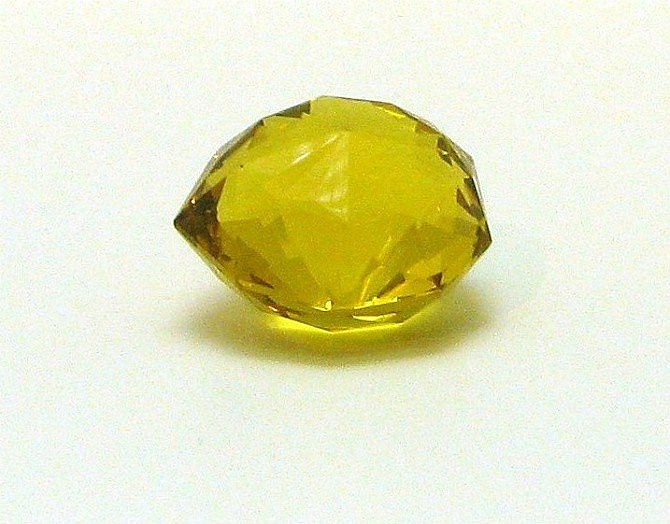 |
| Photo Luxatic |
According to legend, the 132.27-carat yellow diamond was carried as a talisman by Charles the Bold, Duke of Burgundy, into the 1477 Battle of Nancy. The treasure, however, did little to protect him, and he fell along with his gem. His mutilated body was later recovered from the battlefield, but the diamond had vanished, allegedly picked up by a scavenger who mistook it for glass and sold it for two francs.
However, in the 1920s, art historian Nello Tarchiani conducted archival research that revealed the diamond had no connection to the Duke of Windsor. The gemstone was discovered in southern India and remained there until the 1500s, when the Portuguese conquered the region. It arrived in Europe soon after and passed through the hands of several illustrious owners, including Ferdinand de' Medici, Duke of Tuscany, in 1601. The Florentine Diamond got its name, and most likely its gleaming, 126-facet double rose cut, from the Medici treasury in Florence.
The diamond was not among the treasures left to the Tuscan state by the last of the Medici ruling family, Anna Maria Luisa de' Medici, when she died in 1743. Instead, Francis Stephan of Lorraine (later Grand Duke of Tuscany and Holy Roman Emperor) bought it for his Habsburg-born wife, Empress Maria Teresa. The Florentine diamond was once part of Vienna's crown jewels. After World War I, the Austro-Hungarian Empire disintegrated, and the diamond is thought to have been taken into exile in Switzerland by its last emperor, Charles I.
But where has it vanished? Many theories exist regarding its disappearance, including the exiled emperor selling it and possibly cutting it into smaller gems for that purpose. Others suspect that it was stolen and smuggled to South America. The diamond's whereabouts are unknown, as there has been no sign of it in years.
| The Florentine Diamond is one of the rarest diamonds, with nine sides and 126 facets. It was once Europe's largest diamond. Where did this exquisite beauty come from? Despite its Indian origins, the Florentine Diamond has spent the majority of its life in Europe. In the beginning, Lode Van Berkem cut it for Charles the Bold, who lived from 1433 to 1477. Its distinguishing feature is a bright yellow hue with a subtle green undertone. On the scale, it weighs an incredible 686.3 carats! |
12. The Jules Rimet Trophy
 |
| Photo the times |
Before the 1966 World Cup in England, the Jules Rimet World Cup trophy was stolen, prompting an extensive investigation.
It happened on March 20, 1966, four months before the tournament, while the prize was on public display at Westminster Central Hall in London.
The trophy was discovered seven days after it was reported missing, much to FIFA and the Football Association's relief.
Previously, FA chairman Joe Mears received a ransom note stating, "If I don't hear from you by Thursday or Friday at the latest, I assume it's one for the POT."
A £15,000 ransom was demanded, but police used a sting operation to apprehend an individual named Edward Betchley.
Betchley claimed he was only acting as a middleman and was sentenced to two years in prison for his role in the scheme.
It is unknown who was responsible for stealing the most valuable commodity in football at the time, but there have been numerous rumors over the years.
Who is second Jules Rimet trophy theft?Surprisingly, the Jules Rimet trophy was stolen for the second time in 1983, 17 years after it went missing in England. The second theft occurred in Brazil and has since vanished into the ether of intrigue and speculation. It was stolen from a display case at the headquarters of the Brazilian Football Association (CBF) in Rio de Janeiro. The Jules Rimet trophy may have been sold to be melted down into gold bars, according to one theory. Such an outcome is unlikely, however, because the trophy is made of gold-plated sterling silver rather than solid gold. |
13. Benin Bronzes
Hundreds of brass and bronze plaques depicting personal ornaments, "items of royal regalia," and animal and human figures comprise the Benin Bronzes. These magnificent works of art, dating from the 16th century, were commissioned to decorate ancestral altars and other sacred places. They were taken from the West African Kingdom of Benin during the colonial era. In the late 1800s, thieves attacked Benin, killing a large number of people before fleeing with the bronzes.
The Benin Bronzes could be found 100% of the time. The stolen Benin Bronzes are housed at the British Museum on Great Russel Street in London. It is open from 10 a.m. to 5 p.m. every day.
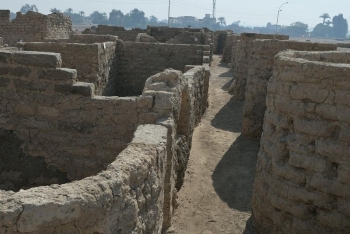 Watch Video 'Lost City' in Egypt: 3,000-Year-Old and Largest Ancient City Watch Video 'Lost City' in Egypt: 3,000-Year-Old and Largest Ancient City Agroup of archaeologists has found the largest ancient city ever discovered in Egypt, dating back 3,000 years. The city, named "The Rise of Aten," ... |
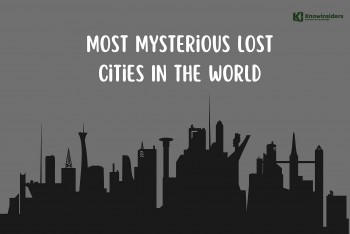 Top 13 Most Mysterious Lost Cities In The World Top 13 Most Mysterious Lost Cities In The World Can you imagine how a city got lost? There are many reasons why a city has to be abandoned. They might be war, natural disasters, ... |


